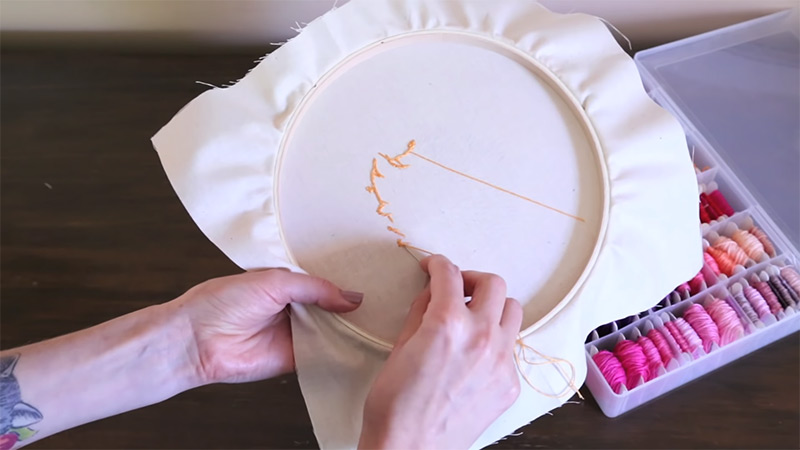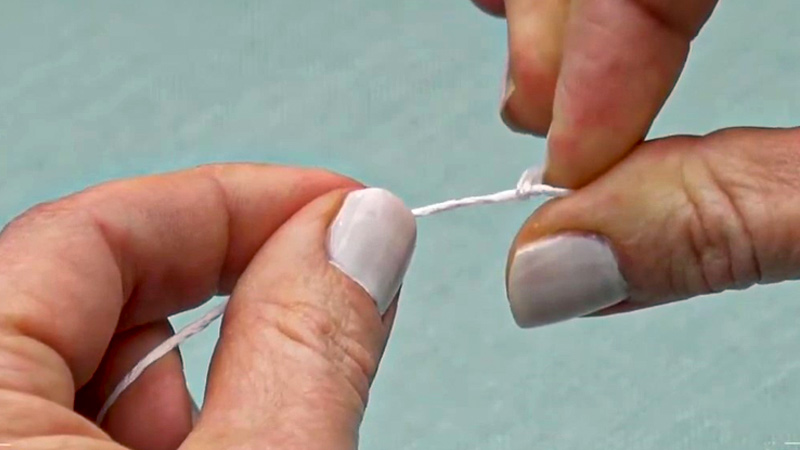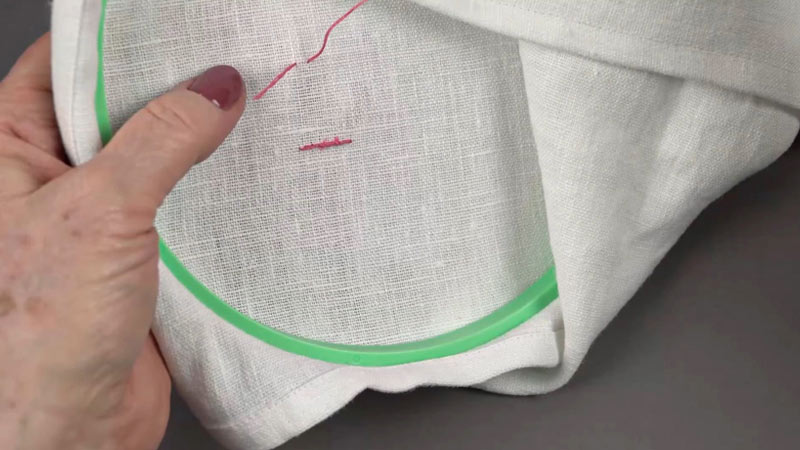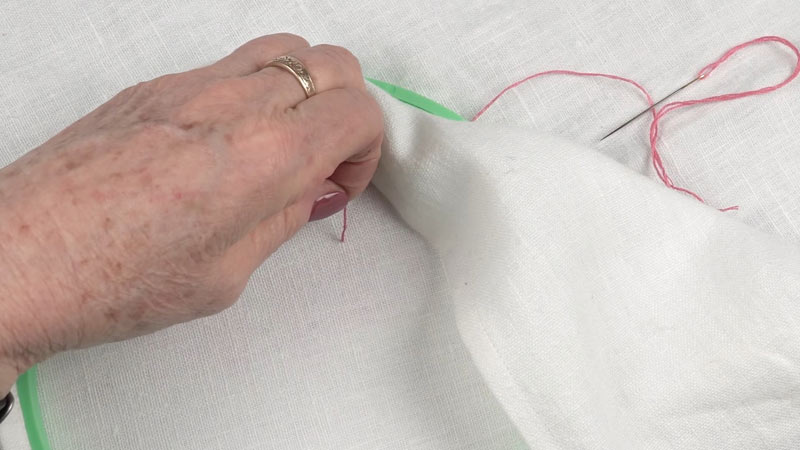Embroidery, an art form that weaves intricate designs with needle and thread, invites a question at its core: Do you knot the back of embroidery?
This seemingly simple inquiry unveils a world of techniques and considerations that impact stitched creations’ stability, aesthetics, and longevity. Knotting, a traditional method, secures threads but may introduce challenges.
Alternatively, knotless techniques promise a smoother finish. In this exploration, we delve into the choices embroiderers face, unraveling the intricacies of knotting and knotless methods.
Join us as we navigate the artistry behind embroidery, seeking answers to the question at its foundation.

Do You Knot the Back of Embroidery?
Yes, knotting the back of embroidery is a common technique used to secure the threads and prevent unraveling. This involves tying a small knot at the end of the thread on the backside of the fabric.
The knots provide stability and durability to the embroidery, ensuring that the stitches remain in place over time.
However, some embroiderers may choose alternative methods, such as weaving the thread under existing stitches or leaving loops, to avoid bulkiness on the backside.
The decision to knot or not knot the back of embroidery often depends on personal preference, the type of project, and the desired finish.
Benefits of Knotting the Back of Embroidery

Knotting the back of embroidery offers several benefits, contributing to the finished project’s overall stability, longevity, and aesthetic appeal. Here are some key advantages:
Thread Security
Knotting provides a secure way to anchor the thread to the fabric, preventing it from unraveling or coming loose over time.
Durability
Knotted threads create a strong and durable bond, making the embroidery more resistant to wear and tear. This is especially important for garments or accessories requiring regular use.
Stability
Knots add stability to the embroidery, ensuring that the stitches remain in place and maintain their intended position on the fabric.
Ease of Handling
Knotted threads are easier to handle during the embroidery process. They stay in place, allowing the embroiderer to focus on creating intricate and precise stitches without constant concerns about thread security.
Prevention of Unraveling
Knots at the end of the thread act as a barrier, preventing the thread from slipping through the fabric weave and unraveling the embroidery.
Versatility
Knotting is a versatile technique that can be used on various fabrics and for different embroidery styles. It is a universal method applicable to both beginners and experienced embroiderers.
Facilitation of Layering
In cases where multiple layers of stitches or different thread colors are used, knots help anchor the threads securely, facilitating layering without compromising the overall integrity of the embroidery.
Added Tension Control
Knots allow for better control of tension in the embroidery. They ensure that the thread remains taut, preventing any sagging or distortion of the design.
Prevention of Tangling
Knotted threads are less likely to tangle with other threads on the back of the fabric, making it easier to manage and maintain neat and organized embroidery.
Ease of Inspection
Knots provide a clear and visible indication of the starting and ending points of the embroidery, making it easier to inspect and assess the quality of the stitching.
Drawbacks of Knotting the Back in Embroidery

While knotting the back of embroidery has its benefits, there are also some potential drawbacks to consider. These drawbacks may influence the decision of whether to use knots or explore alternative techniques. Here are some common drawbacks:
Bulkiness
Knots can create a raised or bulky texture on the back of the fabric, which may not be desirable in certain projects, especially those where a smooth finish is crucial.
Visibility
Knots on the back of the fabric might be visible through thinner or more transparent materials. This visibility can impact the overall aesthetics of the embroidery, especially if it is meant to be seen from both sides.
Interference with Hoop Placement
For some embroidery projects, knots may interfere with the placement of the embroidery hoop, making it challenging to maintain even tension while stitching.
Potential Irritation on Wearable Items
On garments or other wearable items, knots can cause discomfort or irritation if they come into contact with the skin. This is particularly relevant for items like shirts or undergarments.
Difficulty in Framing
If the embroidered piece is intended for framing, knots can create unevenness and make it challenging to achieve a smooth appearance when the fabric is stretched over a backing board.
Thread Snagging
Knots may snag on surrounding threads or fabric, leading to potential damage or distortion of the embroidery, especially if the project involves frequent handling.
Limitation in Layering
Knots may limit the ability to smoothly layer threads without creating visible bumps or disruptions in projects with intricate layering or stitching on both sides of the fabric.
Challenges in Reversing Designs
If the back of the embroidery is meant to be as aesthetically pleasing as the front (for reversible designs), knots may pose challenges in achieving a clean and polished look on both sides.
Increased Thread Consumption
Knotting consumes more thread than knotless techniques, which may be a consideration for projects focusing on efficiency or cost-effectiveness.
Skill Level and Preferences
Some experienced embroiderers may prefer knotless techniques, finding them more aesthetically pleasing or suitable for specific embroidery styles.
How to Decide Whether to Knot or Not Knot the Back of Your Embroidery?

Deciding whether to knot or not knot the back of your embroidery depends on various factors, including personal preference, the type of project, and the desired outcome.
Here are some considerations to help you make an informed decision:
Project Type
Consider the nature of your embroidery project. For items like wall hangings or pieces meant for framing, the back may not be visible, allowing more flexibility in your choice.
On the other hand, for wearable items or reversible designs, the back may be more visible, influencing your decision.
Fabric Characteristics
Different fabrics behave differently; some may be more prone to showing knots or bulkiness on the back. Consider the type of fabric you’re using and how it responds to knotting.
Aesthetic Preferences
Think about your personal style and aesthetic preferences. Some embroiderers prefer a clean and smooth back without knots, while others may find the presence of knots charming or authentic.
Level of Detail
The level of detail in your embroidery may impact your decision. Intricate designs or projects with multiple layers of stitches might benefit from knotless techniques to maintain a smoother appearance.
Wearable Items
If you’re creating garments or accessories, consider the comfort factor. Knots on the back of wearable items can sometimes cause irritation, so you may opt for knotless techniques in such cases.
Embroidery Technique
Certain embroidery techniques or styles may lend themselves better to knotting or knotless methods. Experiment with both to see which works best for your preferred techniques.
Ease of Handling
Consider how easy it is to work with knots or knotless methods based on your skill level and experience. Some beginners find knotting easier, while more experienced embroiderers may prefer knotless techniques.
Stability and Longevity
Assess the stability and longevity of your embroidery. Knots provide a secure anchor, but knotless techniques can also be effective when done correctly. Consider the intended use of the finished piece and how well it needs to withstand wear and tear.
Experimentation
Don’t hesitate to experiment with both techniques on a small sample or scrap fabric. This allows you to see the visual impact, assess the feel of the back, and determine which method aligns better with your vision for the project.
Community Insights
Seek advice from the embroidery community. Online forums, social media groups, or local crafting clubs can be valuable resources for learning about the experiences and preferences of other embroiderers.
FAQs
Are there alternatives to knotting for securing threads in embroidery?
Yes, alternatives include weaving threads under existing stitches or leaving loops. These knotless techniques offer a smoother finish on the back.
What are the potential challenges in framing an embroidered piece with knots on the back?
Knots may create unevenness, making it challenging to achieve a smooth appearance when stretching the fabric over a backing board.
Can knotting the back of embroidery impact the overall weight of the finished piece?
Yes, knots can contribute to a slightly heavier finish, which may be a consideration for projects where weight is a concern, such as delicate fabrics or items like lightweight clothing.
How do I handle thread color changes when knotting the back of embroidery?
Manage thread color changes strategically to avoid knots becoming visible through lighter-colored fabrics. Plan ahead and secure threads in a way that complements the overall design.
To Recap
In the rich tapestry of embroidery, the decision to knot or not becomes a defining thread, weaving through the art’s intricacies.
As we conclude our exploration, we recognize that the choice between knotting and knotless techniques is nuanced, blending tradition with innovation.
Whether crafting timeless pieces or contemporary designs, embroiderers navigate a landscape where personal preference harmonizes with project demands.
The beauty of embroidery lies not just in the stitches adorning the front but also in the thoughtful decisions shaping the unseen back.
Embrace the diversity of methods, experiment with finesse, and let the artistry of each stitch tell a unique story on both sides of the fabric.
Leave a Reply